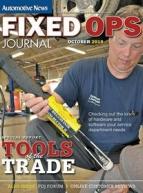The integration of fixed ops data generated separately by Tire Profiles and Dealer-FX is not unique, says Dave Boyle, CEO of Tire Profiles. He notes his company also provides data to vendors of other software and customer relationship management products, including Dealer Tire and AutoLoop.
“We have about 80 integration partners worldwide, on the OEM, aftermarket and dealership levels,” Boyle tells Fixed Ops Journal. “We built our architecture in a way that would make it easier to integrate with partners like Dealer-FX.”
Other equipment manufacturers also focus on integrating their products with those of other vendors. Hunter Engineering offers several systems that enable dealership service departments to gather tire, alignment and license plate data automatically. These include Quick Check, Quick Tread Edge and Quick ID.
Dealer-FX says it is exploring data integration with Hunter Engineering in a process similar to its arrangement with Tire Profiles and other vendors.
Automotive marketing company AutoPoint integrates tire and alignment data from Hunter diagnostic tools with its own multipoint inspection system, says Dara Goroff, Autopoint’s vice president of product management.
“We eliminate any manual entry” of data in dealership service drives, Goroff says. “We can provide specific data on tires and send it to customers in real time.”
Hunter’s Quick Check initially required some manual labor to scan a vehicle, leading to lower use rates, says Alex Smith, the company’s inspection lane product manager. “When shops would get overloaded, they would sometimes drop the alignment scan,” he says.
In July, Hunter released a new version called Quick Check Drive. “It’s now a touchless system,” Smith says. “Cars roll through the system just as they roll over the tire scanners, so utilization is 100 percent.”
Hunter’s Quick systems cost as much as $89,000 per service lane when a dealership buys them together. A system composed of the tire scanner and Quick ID license plate recognition is closer to $45,000, Smith says.
Quick Check Drive takes a set of photos of each vehicle passing through the system to identify any existing damage. Hunter says it is looking at supplying these photos to vendors of digital multipoint inspection software.
“If they do that,” says AutoPoint’s Goroff, “it’d be an ideal integration point for us.”

